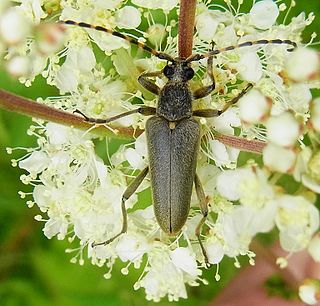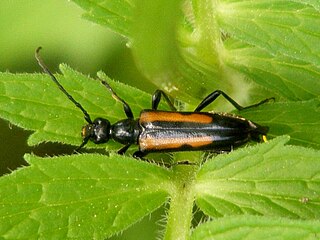Ropalopus sanguinicollis is a species of long-horned beetle in the family Cerambycidae. It is found in the northeastern United States and southern Canada.

The ornate shrew, is a species of mammal in the family Soricidae (shrews). It is endemic to western North America, ranging from Northern California in the United States to Baja California in Mexico. Eight subspecies are known, including the extinct tule shrew, known only from four specimens collected in 1905, and the Suisun ornate shrew, a species of conservation concern in California. Through skull morphology research and genetic testing on Ornate shrew populations, it has been shown that there are three main genetic subdivisions: The Southern, Central and Northern. These three genetic subdivisions of Ornate shrew arose from populations of Ornate shrews getting geographically isolated from other populations.

Panulirus ornatus is a large edible spiny lobster with 11 larval stages that has been successfully bred in captivity.

Anisocerus is a genus of long-horned beetles in the family Cerambycidae. There are at least two described species in Anisocerus.

Lepturobosca is a genus of longhorned beetles in the family Cerambycidae.
Caraphia is a genus of longhorned beetles in the family Cerambycidae, found in Central America.

Strangalepta is a genus containing only one species, Strangalepta abbreviata, a longhorned beetle in the family Cerambycidae.

Ochrus is a genus of beetles in the family Cerambycidae, containing the following species:
Haruspex is a genus of beetles in the family Cerambycidae, containing these species:

Plectromerus is a genus of beetles in the subfamily Cerambycinae, and the only genus in the tribe Plectromerini. It contains the following species:

Trachyderini is a tribe of long-horned beetles in the family Cerambycidae. There are at least 140 genera and 650 described species in Trachyderini.
Colobeutrypanus is a genus of beetle in the family Cerambycidae, with two species, both from the Neotropical region The species are C. ornatus Tippmann, 1953 and C. barclayi Monné & Monné, 2012.
Dorcasina matthewsii is a species of flower longhorn in the beetle family Cerambycidae. It is found in North America and was described by John Lawrence LeConte in 1869.
Ochrus ornatus is a species of beetle in the family Cerambycidae. It was described by Fisher in 1935.
Haruspex ornatus is a species of beetle in the family Cerambycidae. It was described by Bates in 1870.
Plectromerus ornatus is a species of beetle in the family Cerambycidae. It was described by Fisher in 1947.
Dmytro Zajciw was a Ukrainian and Brazilian entomologist, notable for his collection and for his many beetle discoveries. He was born in Velyka Mykhailivka, Ukraine and died in Rio de Janeiro, Brasil. He was the author of Two new genera and species of neotropical Longhorn beetles , 1957, Contribution to the study of Longhorn beetles of Rio de Janeiro , 1958, and was the first to describe the genera Adesmoides and Pseudogrammopsis, as well as the species Beraba angusticollis and Mionochroma subaurosum, among many others.

Ropalopus is a genus of long-horned beetles in the family Cerambycidae. There are about 20 species of Ropalopus found in Eurasia, and a single species, Ropalopus sanguinicollis, found in the northeastern United States and southern Canada.

Tragosoma harrisii is a species of long-horned beetle in the family Cerambycidae.
Cortodera subpilosa, the western mountain flower longhorn, is a species of flower long-horned beetle in the family Cerambycidae. It is found in the northwestern United States and southwestern Canada. Adults are dark brown to black, 7 to 13 mm in size, and are covered with fine hair.









